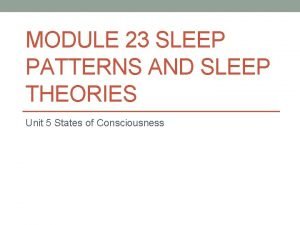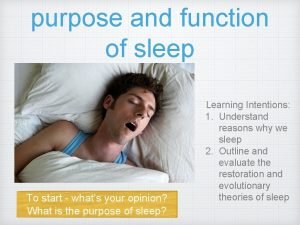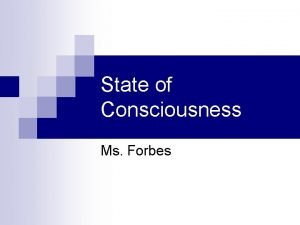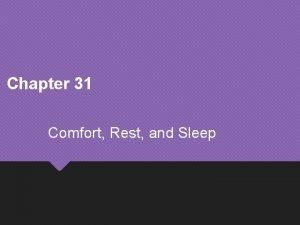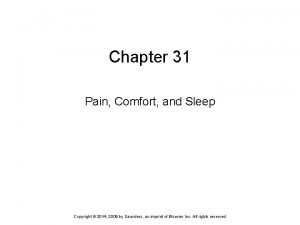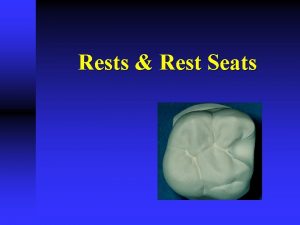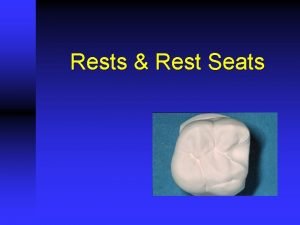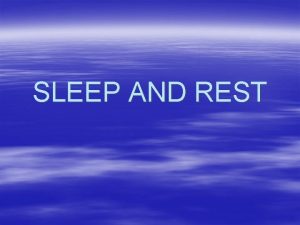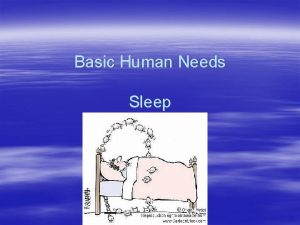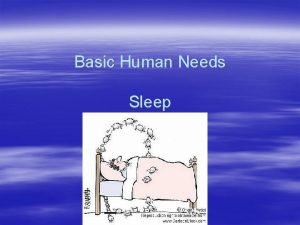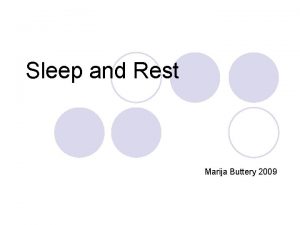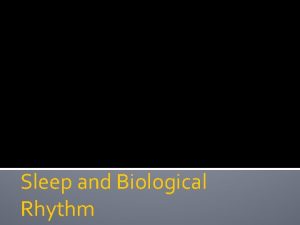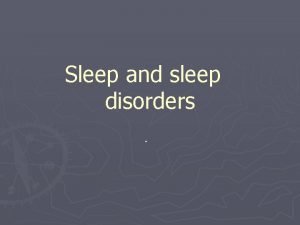SLEEP AND REST Definitions Rest is a condition











- Slides: 11

SLEEP AND REST

Definitions § Rest: is a condition in which the body is in a decreased state of activity without emotional stress and freedom from anxiety. § Sleep: is a state of rest accompanied of altered level of consciousness and relative inactivity, and perception to environment are decreased.

Adequate rest and sleep are important in: § § Promoting general health. Ensuring recovery from illness. Aid healing process. Increase ability to learn and concentration and recalling know lodge. § Help person to be socially adaptable.

Sleep and rest disturbance will be imply: § § § Irritable, anxiety and stress. Fatigue. Reduce work optimally Seek assistance from physician. Poor concentration. Difficulty making decisions.

Normal sleep patterns and requirements: § § § § Newborn: 16 -18 hours /day Infants: some 22 hours, and others from 12 -14 Toddlers: 10 -12 hours Preschool: 11 -12 hours School-Age: 8 - 12 hours Adolescents: 8 -10 hours Adult: 6 -8 hours Elders: 6 hours

Factors Affecting Sleep § § § § § Developmental considerations Psychological stress Motivation Culture Lifestyle and habits Physical activity and exercise Dietary habits Environmental factors Illness Medications

Classification of Sleep Disorders § Dyssomnias — characterized by insomnia or excessive sleepiness § Parasomnias — patterns of waking behavior that appear during sleep § Sleep disorders associated with medical or psychiatric disorders § Other proposed disorders

Dyssomnias § § Insomnia: difficulty falling asleep Hypersomnia: excessive sleep Narcolepsy: uncontrollable desire to sleep Sleep apnea: absence of breathing between snoring intervals § Restless leg syndrome § Sleep deprivation

Parasomnias § § § Somnambulism: sleep walking Sleep talking Nocturnal erections Bruxism: grinding of teeth during sleeping Enuresis Sleep-related eating disorder

Treatment for dyssomnias § Pharmologic therapy – Sedatives and hypnotics § Nonpharmacologic therapy – Stimulus control – Sleep restriction – Sleep hygiene – Cognitive therapy – Multicomponent therapy – Relaxation therapy

Nursing Interventions to Promote Sleep § § § § § Prepare a restful environment Promote bedtime rituals Offer appropriate bedtime snacks and beverages Promote relaxation and comfort Use night light Provide privacy Schedule nursing care to avoid disturbances Use medications to produce sleep Encourage patient to void before sleep Remove any irritants against patients skin such as moist or wrinkled sheets
 Feature of size
Feature of size Module 16 sleep patterns and sleep theories
Module 16 sleep patterns and sleep theories Module 23 sleep patterns and sleep theories
Module 23 sleep patterns and sleep theories Module 23 sleep patterns and sleep theories
Module 23 sleep patterns and sleep theories For sidney sleep is livelier than reality because
For sidney sleep is livelier than reality because Adults spend about ______% of their sleep in rem sleep.
Adults spend about ______% of their sleep in rem sleep. Chapter 31 comfort rest and sleep
Chapter 31 comfort rest and sleep Chapter 31 pain comfort and sleep
Chapter 31 pain comfort and sleep Double embrasure rest seat
Double embrasure rest seat Direct retainer in rpd
Direct retainer in rpd Rest seat prep
Rest seat prep Hamlet in purgatory
Hamlet in purgatory

